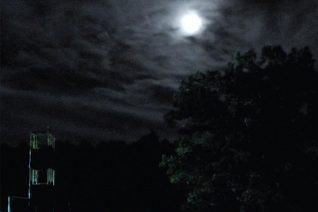Although Angela Jimenez wasn’t born in the Midwest, she — along with thousands of other women over the past three decades — has found a “home” in a 650-acre field in Hart, Mich.
Jimene and her camera spent six years documenting the work of the women who stage the annual Michigan Womyn’s Music Festival, a musical celebration of lesbian and feminist culture. The out New York City-based photojournalist and graduate of the University of Pennsylvania will release “Welcome Home: Building the Michigan Womyn’s Music Festival” at this week’s event. The 120-page publication is the first documentary photography book to profile the festival.
The festival began in 1976 as a means to showcase lesbian and feminist musicians and provide a gathering space for their fans and the larger community. The festival, which attracts up to 10,000 visitors each year, is put together entirely through volunteer labor, with about 100 women setting up camp on the land several weeks before the week-long event to construct stages and other structures, then staying several weeks after to restore the area.
Jimenez became acquainted with the festival in 2003, when she was asked to photograph the event as her first assignment for New York City lesbian magazine Velvetpark.
“That year, I went to explore and observe, and I made some photos that I really loved. But there was a feeling of incompletion when I left. I knew that there was more that I wanted to explore, but I just wasn’t sure how,” she said. “So the next year I went back as a craftsperson with Velvetpark and worked at a booth where we sold the magazine, and then the following year I went back with my girlfriend at the time, and that was the year that I met all the workers and that’s when it just clicked for me. I realized that this was the story I wanted to explore.”
Jimenez submitted a proposal to the festival organizers, asking if she could come document the month-long preparation process. At the time she still wasn’t sure what the result would be, and the suggestion that she create a book actually came from the workers themselves that summer.
She captured the women at work on the construction of the festival structures, taking part in the traditions and rituals that began more than 35 years ago; and in leisure, providing a glimpse into the often-invisible driving force behind the festival.
“These women are the major foundation of the festival, and through them I thought I could really tell the story about what the community is and what this event is,” Jimenez said. “The book is made from the perspective of the worker community; it’s a story that’s an important part of herstory. I feel like it’s never been told before.”
Jimenez said she strove to project the irrefutable culture and ties that exist among the women who return year after year to set up and deconstruct the festival — a culture that was initially foreign to her, but one she eventually embraced.
“The workers greet each other every summer by saying, ‘Welcome home.’ I remember that being one of the first things that I saw when I went out there. And I thought it was weird at first since I’d never been there before, but I never forgot it. But that’s the feeling. It’s a really tight-knit community and everyone refers to each other as family and they welcome people home each summer, which I think is really emblematic of the family that exists there.”
Jimenez immersed herself fully into that family the past two summers, when she divided her time between photographing the workers and participating in the construction as part of a carpentry team.
Jimenez, who received her bachelor’s degree in English from Penn in 1997 and later her master’s degree in photojournalism from the University of Missouri, said her journalism training taught her to remove herself from the stories she was covering. Yet in order to fully tell the story of the worker community, she had to deviate from her training and become a part of the story.
“The experience was really challenging for me. My heart is always in the stories that I do — I don’t really believe in the concept of complete objectivity because I think you always bring a part of yourself to it — but this was different because I was documenting this community as I was going through my own experiences with it. It was like I had to unlearn a lot of things. I was trained in this way where you’re supposed to observe what’s outside of you and try to keep yourself out of it, but I was involved in it and I wanted to be honest about that.”
Jimenez included photos of herself in the book, which she said was something she’s never done before, but was necessary in order to relay that the book is based on a first-person perspective.
She said the publication could be considered a “cross-over” between the fields of photojournalism and art.
“The way I think about it, traditionally journalism is the observation and commentary on the other; it’s something outside of you. Art is more defined as self-expression or a statement of self. It was challenging to balance that, but I think the book extends into both of these areas.”
For more information about “Welcome Home,” or to purchase a copy, visit www.thewelcomehomebook.com.
Jen Colletta can be reached at [email protected].
